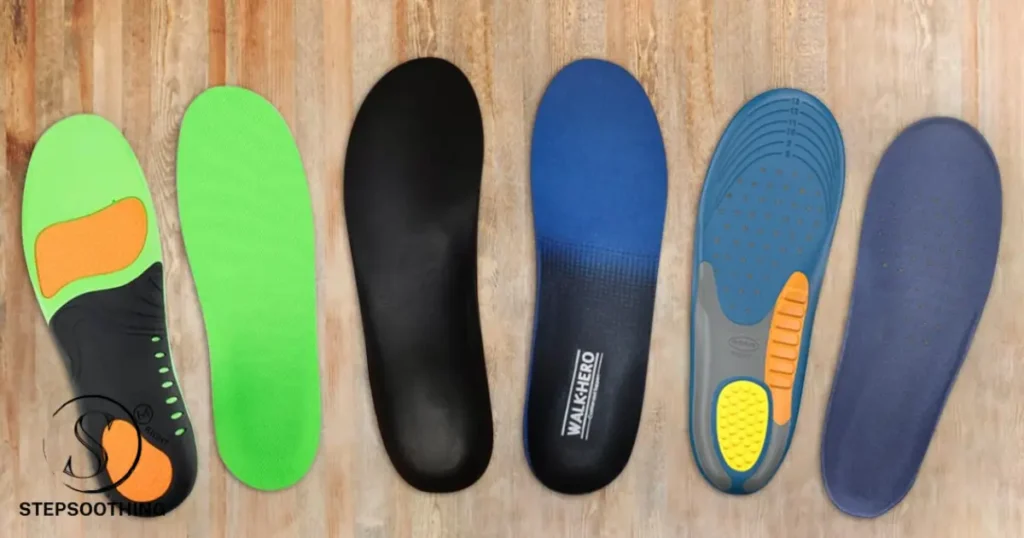Are you tired of dealing with foot pain that seems to follow you everywhere you go? Say goodbye to that discomfort with our solutions, including Arch Support Insoles. Whether it’s from standing all day at work, engaging in sports activities, or simply the wear and tear of daily life, finding relief for your aching feet can be a game-changer.
This comprehensive guide is here to help you navigate the world of arch support insoles, empowering you to make informed decisions that can alleviate discomfort and enhance your overall foot health.

The Ultimate Guide to Choosing Arch Support Insoles for Pain Relief
I. Identifying Your Foot Arch Type
Before diving into the world of arch support insoles, it’s crucial to understand your foot arch type for optimal comfort and support. Whether you have flat feet, neutral arches, or high arches can significantly impact the type of support your feet need, making understanding your arch shape essential. Determining your foot arch type will guide you in selecting the most suitable insoles that cater to your specific needs.
II. Common Foot Problems and Solutions
From plantar fasciitis to overpronation and supination, there are a variety of common foot problems that can cause discomfort and affect your daily activities. Arch support insoles can play a vital role in addressing these issues by providing the necessary support and cushioning to alleviate pain and promote proper foot alignment.

The Importance of Proper Footwear: Enhancing Comfort and Support
Insoles are not a standalone solution; they complement the importance of wearing proper footwear. Shoes that offer adequate support, cushioning, and stability can work in synergy with insoles to maximize comfort and alleviate foot pain. When choosing shoes, look for features such as arch support, cushioned soles, and a design that promotes proper foot alignment.
Additionally, for individuals with specific foot conditions or structural issues, customizing footwear with removable insoles can provide an extra layer of support tailored to their needs. Don’t let discomfort hold you back – invest in quality shoes and compatible insoles to support your feet throughout the day.
I. Choosing the Right Material and Design
When it comes to selecting arch support insoles, considering the material and design is key. Materials like gel, foam, or orthotic support offer different levels of cushioning, stability, and shock absorption. Additionally, choosing between full-length, 3/4 length, or heel cups depends on your comfort preferences and the type of footwear you’ll be using them with.
II. Finding the Perfect Fit
Ensuring a proper fit is essential when it comes to arch support insoles to achieve the best comfort and support for preventing back pain and other discomforts. Ill-fitting insoles can do more harm than good, so taking the time to find the right size and shape for your feet is crucial. It’s recommended to try on insoles with your regular shoes to ensure they provide adequate support without causing discomfort and prevent pain effectively.
III. Expert Tips for Maximum Comfort
To ensure maximum comfort and effectiveness when wearing arch support insoles, follow these expert tips:
- Ensure a proper fit: Insoles should match the contours of your feet without causing discomfort or slippage.
- Gradual break-in: Allow time for your feet to adjust to the new insoles by wearing them for short periods initially.
- Regular maintenance: Keep your insoles clean and dry to prevent odor and prolong their lifespan.
- Replace as needed: Over time, insoles may wear out and lose their effectiveness, so replace them when necessary for continued support.
IV. Maintenance and Care
Here are some tips for maintaining and caring for your arch support insoles:
- Clean your insoles regularly: Wipe down your insoles with a damp cloth or sponge to remove dirt and sweat buildup. For a more thorough cleaning, you can hand wash them with mild soap and water. Make sure to air dry them completely before putting them back in your shoes.
- Rotate your insoles: To allow your insoles to fully dry out and prevent odor accumulation, it’s a good idea to rotate between multiple pairs of insoles. This also helps extend the lifespan of each pair, as they will experience less wear and tear.
- Store in a dry, well-ventilated area: After cleaning your insoles, make sure to store them in a dry and well-ventilated area. Avoid placing them in direct sunlight or near a heat source, as this can cause them to deteriorate more quickly.
- Replace when necessary: Over time, the cushioning and support in your insoles will start to wear down. If you notice that your insoles are no longer providing the same level of comfort and support, it’s time to replace them. Typically, arch support insoles should be replaced every 6-12 months, depending on how often they are worn and the intensity of the activities they are used for.
By following these maintenance tips and knowing when to replace your arch support insoles, you can ensure that your feet are properly supported and protected. Proper care will not only prolong the lifespan of your insoles but also benefit your overall foot health in the long run.
V. Understanding Arch Support Insoles
Arch support insoles are specially designed inserts that provide additional support to the arch of your foot, enhancing comfort and support. They work by redistributing pressure, promoting proper alignment, and offering shock absorption, which can help alleviate pain and prevent further issues. These insoles come in various materials and designs, each offering unique benefits for different foot conditions, including heel pain and enhancing weight distribution.

Types of Arch Support Insoles
- Custom Orthotics: These are personalized inserts made based on a mold of your feet, providing tailored support for your specific arch type.
- Over-the-Counter Insoles: Readily available in stores, these generic insoles offer basic arch support and are suitable for mild to moderate foot issues.
- Gel Insoles: Known for their cushioning properties, gel insoles provide comfort and shock absorption, ideal for individuals with sensitive or sore feet.
- Foam Insoles: Lightweight and flexible, foam insoles offer moderate arch support and are often used for everyday wear or athletic activities.
The Benefits of Custom Insoles: Tailored Support for Your Feet
While generic insoles available in stores can provide some level of comfort, custom insoles designed specifically for your feet offer a whole new level of support and relief. These personalized inserts are crafted based on a 3D map of your feet, taking into account your arch shape, pressure points, and any existing foot conditions. The result is a perfect fit that addresses your unique needs and provides targeted support where you need it most.
Custom insoles offer several benefits:
- Personalized Support: Custom insoles provide support tailored to your feet, ensuring optimal comfort and alignment.
- Pain Relief: By addressing specific areas of discomfort or pain, custom insoles can help alleviate common foot conditions typically caused by poor alignment or inadequate support.
- Improved Foot Function: With proper support, your feet can function more efficiently, reducing fatigue and strain during daily activities.

How to Choose the Right Arch Support Insoles
Selecting the appropriate arch support insoles is crucial for maximizing their benefits. Consider the following factors when choosing the right pair:
- Understanding Your Foot Arch Type: Determine whether you have flat feet, high arches, or neutral arches to select insoles that cater to your specific needs.
- Material and Design Considerations: Look for insoles made from durable materials like EVA foam or silicone gel, with features such as cushioning, shock absorption, and moisture-wicking properties.
- Proper Fit and Comfort: Ensure that the insoles fit snugly in your shoes without causing discomfort or crowding, allowing for natural movement and support.
Say Goodbye to Arch Pain: How Insoles Can Alleviate Discomfort
Arch pain is a common issue faced by many individuals, especially those with flat feet or high arches. This type of pain can make walking or standing for long periods unbearable. However, insoles designed with arch support can work wonders in alleviating this discomfort. By providing a supportive platform for the arches, these insoles help distribute pressure evenly and prevent excessive strain on the arch area.
Whether you’re dealing with plantar fasciitis, overpronation, or general arch pain, investing in quality insoles with arch support can significantly improve your comfort and mobility. These inserts are often recommended by podiatrists as part of a comprehensive treatment plan for foot conditions, offering a simple yet effective solution for pain relief.
- Plantar Fasciitis: Individuals suffering from plantar fasciitis can benefit greatly from arch support insoles, which help alleviate pain and provide additional cushioning to the heel and arch.
- Flat Feet (Pes Planus): Arch support insoles can help individuals with flat feet by providing the necessary support to reduce strain on the arch and promote better foot alignment.
- High Arches (Pes Cavus): For those with high arches, arch support insoles can help distribute pressure more evenly across the foot, preventing excessive stress on certain areas.

Finding the Right Fit: Tips for Choosing and Using Insoles
When selecting insoles for your shoes, consider the following factors:
- Foot Type: Determine your foot arch type (high, medium, low) to choose insoles that offer the right level of support.
- Activity Level: Consider your daily activities and choose insoles designed for impact absorption if you’re active or on your feet for extended periods.
- Footwear Compatibility: Ensure the insoles fit comfortably inside your shoes without causing crowding or slipping.
Once you’ve chosen the right insoles, follow these tips for optimal usage:
- Replace Regularly: Insoles can wear out over time, so replace them periodically to maintain their effectiveness.
- Clean Regularly: Keep your insoles clean and dry to prevent odor and bacterial growth.
- Consult a Professional: If you have persistent foot pain or discomfort, consult a podiatrist for personalized advice and treatment.
I. Incorporating Insoles into Your Daily Routine
Once you’ve found the perfect pair of arch support insoles, incorporating them into your daily routine is key to reaping their benefits fully. Whether you’re wearing them with athletic shoes, work boots, or casual footwear, adjusting gradually to wearing insoles throughout the day can help improve comfort and reduce foot fatigue.
II. Myth-Busting and Common Misconceptions
Despite their proven benefits, arch support insoles are often subject to myths and misconceptions. One common myth is that wearing insoles can weaken the natural arch muscles over time.
However, research shows that properly designed arch support insoles can actually strengthen the muscles by providing support and reducing fatigue. Another misconception is that insoles are only for people with existing foot problems. In reality, anyone can benefit from wearing arch support insoles, whether you’re an athlete, a professional, or someone who enjoys an active lifestyle.
Consulting a Professional
In some cases, seeking advice from a podiatrist or foot specialist may be necessary, especially if you have underlying foot conditions that require custom orthotics. Understanding the difference between custom orthotics and over-the-counter insoles can help you make an informed decision about which option is best suited for your foot health needs, including considerations for arch shape and weight distribution.
By following this ultimate guide to choosing arch support insoles for pain relief, you’re taking proactive steps towards enhancing your foot comfort and overall well-being. Remember, investing in quality arch support insoles tailored to your specific needs can make a significant difference in how you feel on your feet every day. So why wait? Take that first step towards happier, healthier feet today and enjoy the immediate difference good insoles provide.
Key Takeaways:
- Insoles provide personalized support and relief for various foot conditions.
- Custom insoles offer tailored solutions based on individual foot characteristics.
- Arch support insoles are effective in alleviating arch pain and improving comfort.
- Proper footwear complements the benefits of insoles, enhancing overall foot support.
- Choose and use insoles wisely, replacing them regularly and seeking professional advice when needed.
FAQS People also Asked
Q1.Do arch support insoles really work?
Yes, arch support insoles can be effective in providing support and stability to your feet, especially if you have conditions like flat feet or high arches.
Q2.How do I know if I need arch supports?
You may need arch supports if you experience foot pain, discomfort, or fatigue, especially after prolonged standing or walking. Consult with a podiatrist for a proper assessment.
Q3.How do I choose an arch support insole?
When choosing arch support insoles, consider factors such as your foot arch type, level of support needed, shoe size compatibility, and any specific foot conditions you may have.
Q4.Who needs arch support insoles?
Individuals with flat feet, high arches, overpronation, or foot conditions like plantar fasciitis can benefit from using arch support insoles to improve foot alignment and reduce discomfort.
Q5.Do arch supports hurt at first?
It’s possible to experience mild discomfort initially as your feet adjust to the new support, but this should subside as you wear them regularly and your feet adapt.
Q6.How do I know my foot arch type?
You can determine your foot arch type by conducting a simple wet footprint test or seeking professional advice from a podiatrist or footwear specialist.
Q7.What is the difference between flat feet and arch feet?
Flat feet have a lower or no arch, causing the entire sole of the foot to make contact with the ground. Arched feet have a noticeable curve in the middle of the foot, creating an arch between the heel and the ball of the foot.
Q8.What is the purpose of arch support?
The purpose of arch support is to provide stability, cushioning, and alignment to the foot arch, helping to distribute weight evenly and reduce strain on the muscles and ligaments of the foot.
Q9.What is the difference between flat feet and arched feet?
Flat feet lack a noticeable arch, causing the entire sole of the foot to touch the ground, while arched feet have a distinct curve in the middle, creating an arch between the heel and the ball of the foot. Arch support insoles can help both types of feet by providing the necessary support and alignment.



